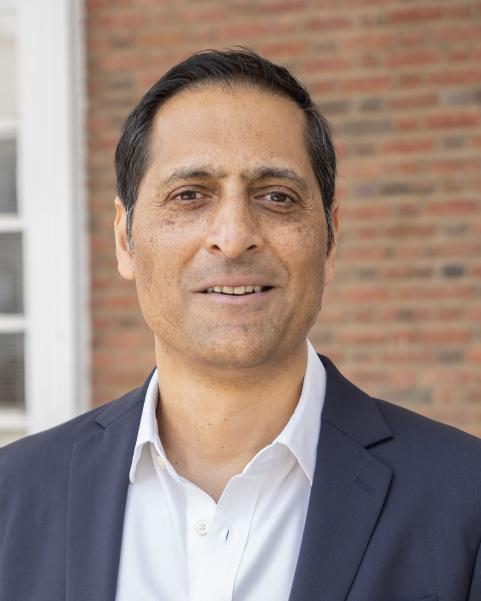Meet Manoj Patel, Professor of Anesthesiology

Manoj Patel, PhD, is a Professor of Anesthesiology in the UVA School of Medicine. Dr. Patel describes his interests and his experience developing sustainable scientific collaborations.
Brain Institute: Briefly describe your current research projects and interests.
Dr. Patel: My current research projects focus on a rare pediatric condition known as SCN8A developmental epileptic encephalopathy (DEE). The SCN8A gene encodes the Nav1.6 sodium channel, which is predominantly expressed in the brain. Nav1.6 is crucial for regulating neuronal excitability, and gain-of-function variants in SCN8A can lead to severe epilepsy and premature death in patients. My lab's research aims to better understand the mechanisms by which Nav1.6 gain-of-function variants contribute to seizures and sudden unexpected death in epilepsy (SUDEP). Additionally, SCN8A is expressed in non-excitable cells, such as oligodendrocyte precursor cells (OPCs). We are conducting studies to determine the role of Nav1.6 in glial cells and to assess the impact of gain-of-function variants on OPCs and the maturation of oligodendrocytes.
How did you get your start in the field of neuroscience?
I identify as an ion channel electrophysiologist. During my Ph.D., I studied ischemia-reperfusion injury in the heart, where I was introduced to various foundational electrophysiology techniques. However, I had a strong desire to learn the patch clamp electrophysiology technique. In my first postdoctoral position at UVA, I received training in patch clamp techniques and recorded neuronal sodium channels expressed in various systems. My second postdoctoral experience significantly deepened my involvement in neuroscience, as I began recording from brain slice preparations and studying neuronal excitability.
Could you tell us about one of your most impactful research collaborations?
My most impactful collaboration has been with Professor Miriam Meisler, Ph.D. at the University of Michigan. She was the first to report on a patient-derived SCN8A variant and has developed two mouse models featuring distinct SCN8A variants. Together, our labs have published a series of papers validating several patient-derived variants, and we have been fortunate to obtain both SCN8A mouse models for additional research studies. Our collaboration has flourished over the past 10 years.
Why are collaborations important to your research program?
Collaborations are critical since a single lab does not always have the capability or expertise to fully tackle a research problem. Collaborations can provide new and innovative thoughts on a research hypothesis and help with solutions to tackle them.
What advice do you have about initiating and building successful and sustainable collaborations?
To maintain a successful collaboration, it's crucial to have a genuine interest in the research project and to contribute new insights or skills. Establishing clear goals and expectations is essential, especially when involving graduate students or postdocs in the study. Building trust among PIs is vital, and having an exit plan in place can be beneficial in case the collaboration doesn't unfold as expected. Since collaborations can significantly impact your time and finances, it's important to recognize when it might be necessary to step back and reassess the partnership.
What advice do you have for trainees and/or junior investigators?
Being a scientist comes with its challenges; not all experiments yield the expected results, and that's perfectly normal. The key is to persevere with the problem and explore alternative approaches to finding solutions. It's also beneficial to seek out role models and mentors who can provide guidance and support when needed. Their experience and insights can be invaluable in navigating obstacles and fostering your growth as a researcher.
What’s something new that you’ve learned recently (at work or outside of work)?
I recently began playing Pickle Ball. It’s a lot of fun!
Where are you from originally?
My parents are of Indian descent, but I was born in Nairobi, Kenya, in East Africa. Shortly after my birth, my family moved to the UK, where I grew up and attended university. When asked where I'm from, I respond that I'm from England, but I also proudly acknowledge my Indian heritage!
What’s your favorite way to spend a day off?
My favorite way to spend my day off is by going to Veritas Vineyard for a picnic and some wine. I especially enjoy their Viognier!
What is a surefire way to make you laugh?
Watching episodes of The Office, Parks and Rec and the movie Something about Mary.